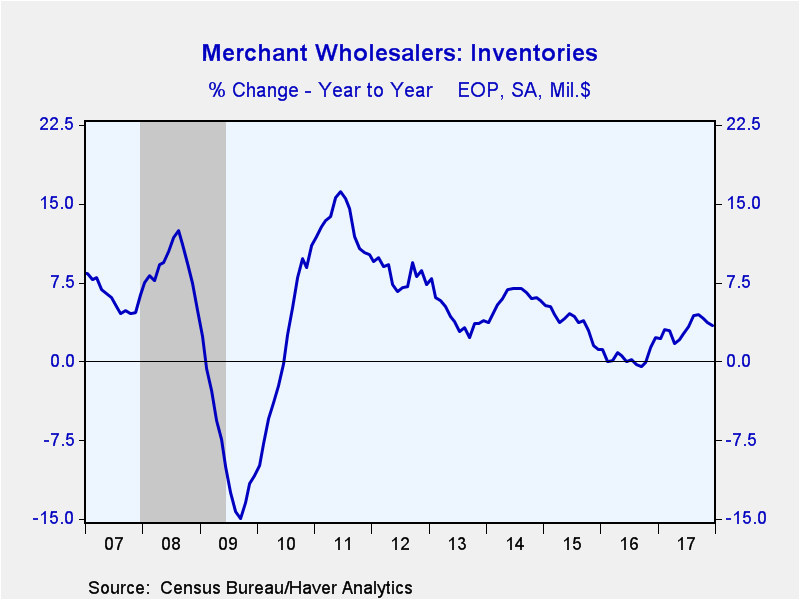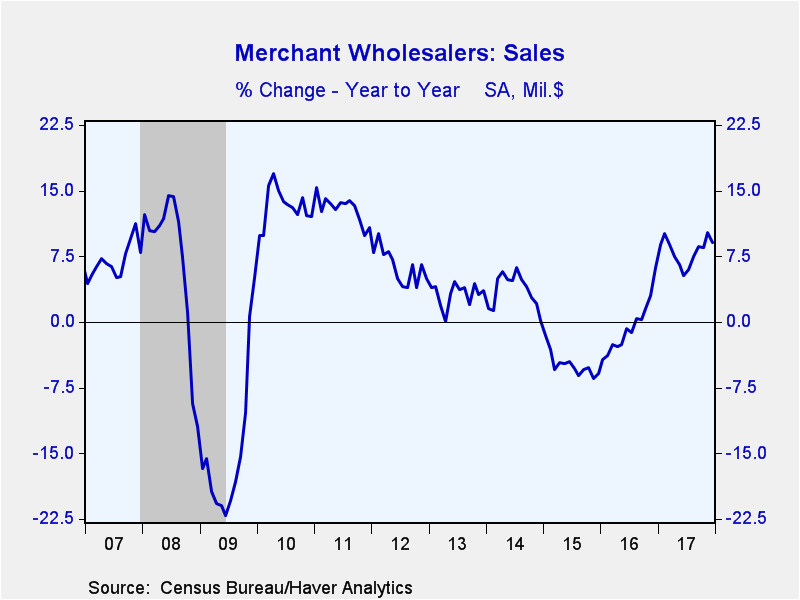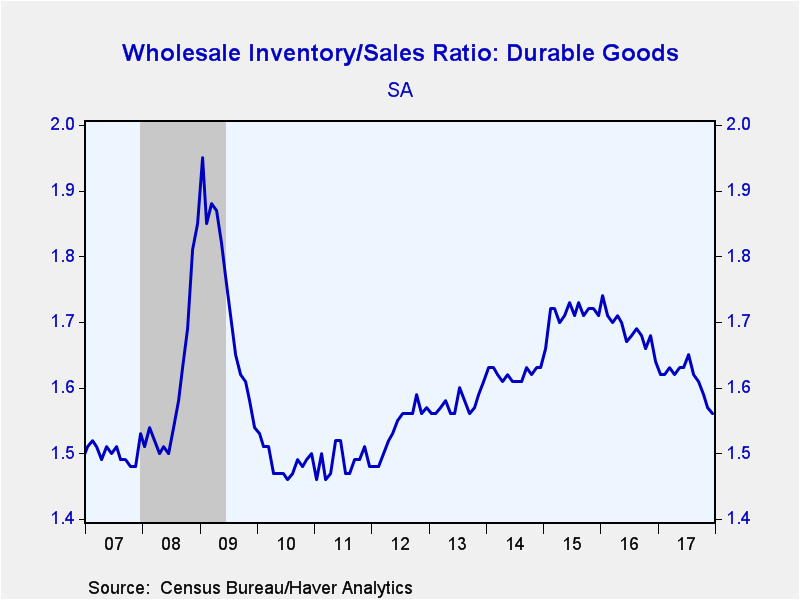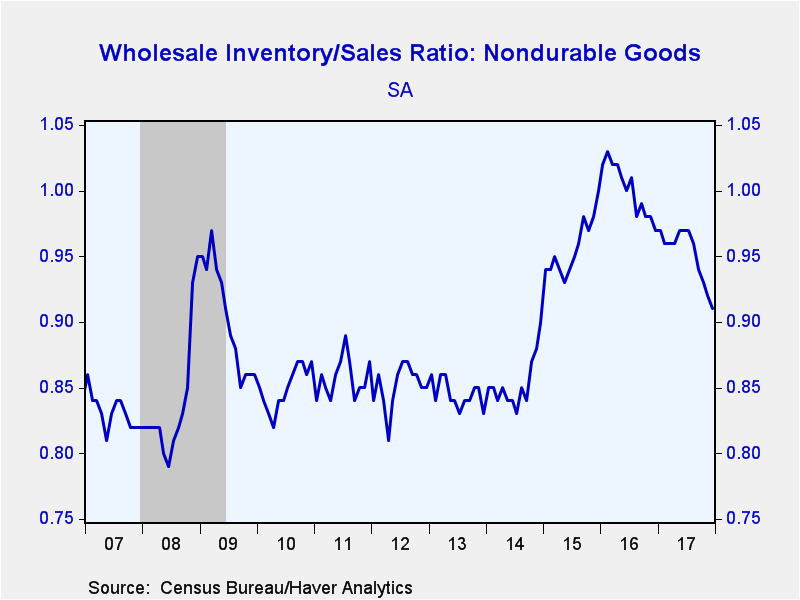 Global| Feb 09 2018
Global| Feb 09 2018U.S. Wholesale Inventories and Sales Strengthen
by:Tom Moeller
|in:Economy in Brief
Summary
During all of last year, inventories at the wholesale level increased 3.5%, the largest increase in three years. During December alone, inventories increased 0.4% (3.5% y/y) following a 0.6% November rise, revised from 0.8%. In the [...]
During all of last year, inventories at the wholesale level increased 3.5%, the largest increase in three years. During December alone, inventories increased 0.4% (3.5% y/y) following a 0.6% November rise, revised from 0.8%. In the advance report issued on January 26, wholesale inventories were reported up 0.2% m/m in December.
In December, durable goods inventories increased 0.4% (4.8% y/y), the same as in November. Motor vehicle inventories gained 2.8% (3.1% y/y). Furniture & home furnishing inventories rose 0.2% (3.5% y/y) and computer equipment inventories increased 0.6% (2.5% y/y). Electrical equipment inventories strengthened 1.2% (11.4% y/y), but machinery inventories fell 0.2% (+2.7% y/y). Inventories of nondurable goods gained 0.4% (1.7% y/y) after a 0.9% rise. The value of chemical inventories jumped 3.2% (3.3% y/y). Farm product raw materials inventories improved 2.2% (9.9% y/y), but apparel inventories eased 0.7% (-4.0% y/y). Inventories of petroleum declined 3.4% (-6.2% y/y).
Sales at the wholesale level strengthened 1.2% (5.9% y/y) in December after a 1.9% November jump. A 0.5% m/m rise had been expected in the Action Economics Forecast Survey.
Nondurable goods purchases increased 1.5% (5.4% y/y) after a 2.2% November rise, as petroleum sales gained 3.3% (22.8% y/y). Chemical product sales rose 2.6% (8.2% y/y), and farm-product sales rose 1.5% (-2.7% y/y). Apparel sales rose 0.2% (-3.2% y/y). Durable goods sales increased 1.0% (6.5% y/y) reflecting a 1.0% rise (12.3% y/y) in sales of machinery, but motor vehicle purchases eased 0.2% (+6.2% y/y). Electrical equipment sales jumped 3.5% (9.1% y/y) but furniture sales ticked just 0.1% higher (-8.2% y/y).
The inventory-to-sales ratio at the wholesale level declined to 1.22 in December, its lowest reading since October 2014. It was below a February 2016 high of 1.36.
The I/S ratio for durable goods continued to decline, falling to 1.56; well below its recent peak of 1.74 in January 2016. The metals & minerals ratio declined to 2.00, and the motor vehicle ratio rose to 1.72. The electrical equipment ratio neared its three-year low of 0.97, but the computer equipment ratio ticked up to 0.86. The I/S ratio for nondurable goods fell to 0.91, its lowest point in three years. The apparel industry ratio declined to 1.96 from is April 2017 peak of 2.17, and the chemical industry ratio was stable at 1.11. The grocery industry ratio held at 0.65, and the petroleum industry ratio dropped sharply to 0.33.
The wholesale trade figures are available in Haver's USECON database. The Action Economic Survey results are contained in AS1REPNA.
Data Point to Momentum in GDP Growth as Year Begins from the Federal Reserve Bank of Dallas is available here.
| Wholesale Sector - NAICS Classification (%) | Dec | Nov | Oct | Dec Y/Y | 2017 | 2016 | 2015 |
|---|---|---|---|---|---|---|---|
| Inventories | 0.4 | 0.6 | -0.4 | 3.5 | 3.5 | 2.6 | 1.1 |
| Sales | 1.2 | 1.9 | 0.8 | 5.9 | 7.6 | -0.4 | -4.9 |
| I/S Ratio | 1.22 | 1.23 | 1.25 | 1.29 (Dec '16) | 1.27 | 1.33 | 1.32 |
Tom Moeller
AuthorMore in Author Profile »Prior to joining Haver Analytics in 2000, Mr. Moeller worked as the Economist at Chancellor Capital Management from 1985 to 1999. There, he developed comprehensive economic forecasts and interpreted economic data for equity and fixed income portfolio managers. Also at Chancellor, Mr. Moeller worked as an equity analyst and was responsible for researching and rating companies in the economically sensitive automobile and housing industries for investment in Chancellor’s equity portfolio. Prior to joining Chancellor, Mr. Moeller was an Economist at Citibank from 1979 to 1984. He also analyzed pricing behavior in the metals industry for the Council on Wage and Price Stability in Washington, D.C. In 1999, Mr. Moeller received the award for most accurate forecast from the Forecasters' Club of New York. From 1990 to 1992 he was President of the New York Association for Business Economists. Mr. Moeller earned an M.B.A. in Finance from Fordham University, where he graduated in 1987. He holds a Bachelor of Arts in Economics from George Washington University.










